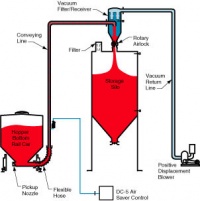Difference between revisions of "Pneumatic Conveying Systems"
(Created page with "Category:Pneumatic Transport{{Knoppen}} <noinclude><!------------------------------------------------ * READ THIS FIRST * Only edit this page if you can improve the content....") |
|||
| Line 1: | Line 1: | ||
[[Category:Pneumatic Transport]]{{Knoppen}} | [[Category:Pneumatic Transport]]{{Knoppen}} | ||
[[File:Pneumatic_Conveying_Systems.jpg|thumb|200px|right|Pneumatic Conveying Systems]] | |||
Every '''pneumatic conveying system''', would makes use of pipes or ducts called transportation lines that carry mixture of materials and a stream of air. These materials are such as dry pulverized or free flowing or light powdery materials like cement, fly ash etc. These materials can be transported conveniently to various destinations by means of a stream of high velocity air through pipe lines. | |||
Products are moved through various tubes via air pressure, allowing for extra vertical versatility. [[Pneumatic Conveyors]] are either carrier systems or [[Dilute Phase Conveyors]]; carrier systems simply push items from one entry point to one exit point, such as the money-exchanging tubes used at a bank drive-through window. Dilute-phase systems use push-pull pressure to guide materials through various entry and/or exit points. It is important to note that either air compressors, vacuums, or blowers can be used to generate the air. This will all depend on what the engineers think will be the most efficient and economical way of developing the system.<ref>http://www.deltaind.net/blowerandvacuumapplications.jsp</ref> | |||
Three basic systems that are used to generate high velocity air stream: | |||
# Suction or vacuum systems, utilizing a vacuum created in the pipeline to draw the material with the surrounding air.The system operated at a low pressure, which is practically 0.4–0.5 atm below atmosphere, and is utilized mainly in conveying light free flowing materials. | |||
# Pressure-type systems, in which a positive pressure is used to push material from one point to the next. The system is ideal for conveying material from one loading point to a number of unloading points. It operates at a pressure of 6 atm and upwards. | |||
# Combination systems, in which a suction system is used to convey material from a number of loading points and a pressure system is employed to deliver it to a number of unloading points. | |||
==Sources== | |||
<references/> | |||
* [http://en.wikipedia.org/wiki/Conveyor_system#Pneumatic_conveyor_systems WikiPedia Pneumatic Conveying System] | |||
Revision as of 12:31, 26 March 2014
Every pneumatic conveying system, would makes use of pipes or ducts called transportation lines that carry mixture of materials and a stream of air. These materials are such as dry pulverized or free flowing or light powdery materials like cement, fly ash etc. These materials can be transported conveniently to various destinations by means of a stream of high velocity air through pipe lines.
Products are moved through various tubes via air pressure, allowing for extra vertical versatility. Pneumatic Conveyors are either carrier systems or Dilute Phase Conveyors; carrier systems simply push items from one entry point to one exit point, such as the money-exchanging tubes used at a bank drive-through window. Dilute-phase systems use push-pull pressure to guide materials through various entry and/or exit points. It is important to note that either air compressors, vacuums, or blowers can be used to generate the air. This will all depend on what the engineers think will be the most efficient and economical way of developing the system.[1]
Three basic systems that are used to generate high velocity air stream:
- Suction or vacuum systems, utilizing a vacuum created in the pipeline to draw the material with the surrounding air.The system operated at a low pressure, which is practically 0.4–0.5 atm below atmosphere, and is utilized mainly in conveying light free flowing materials.
- Pressure-type systems, in which a positive pressure is used to push material from one point to the next. The system is ideal for conveying material from one loading point to a number of unloading points. It operates at a pressure of 6 atm and upwards.
- Combination systems, in which a suction system is used to convey material from a number of loading points and a pressure system is employed to deliver it to a number of unloading points.
